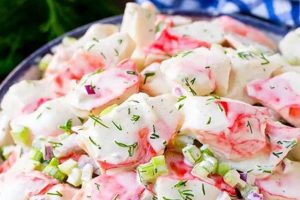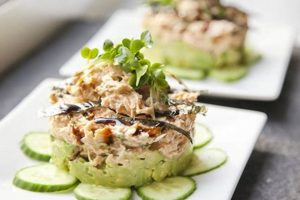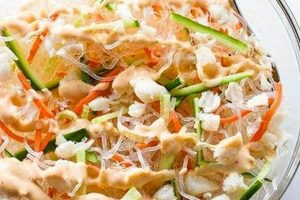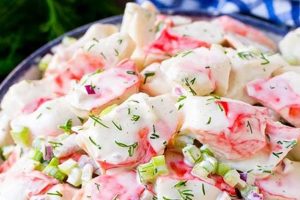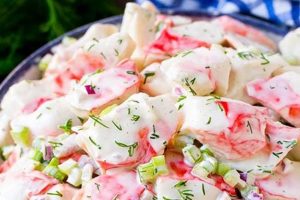A straightforward preparation of this dish typically involves combining cooked crab meat with a minimal number of ingredients, such as mayonnaise, celery, onion, and seasonings. Variations might include Dijon mustard, lemon juice, or Old Bay seasoning. A basic version can be prepared quickly, offering a light and refreshing meal or appetizer.
Easy-to-make versions of this seafood salad offer accessibility for home cooks of all skill levels. The simplicity allows the natural sweetness of the crab to shine, while the limited ingredients contribute to a lighter, healthier option compared to more complex, calorie-rich salads. Historically, similar seafood salads have been enjoyed for centuries, adapting to available regional ingredients and culinary traditions. The modern emphasis on quick preparation reflects current lifestyles.
The following sections will explore specific ingredient recommendations, variations, and tips for achieving optimal flavor and texture. Additional information regarding safe handling of seafood and suitable accompaniments will also be provided.
Tips for a Simple Crab Salad
Achieving a delicious and effortless crab salad relies on a few key techniques. These tips focus on ingredient selection and preparation methods for optimal flavor and texture.
Tip 1: Fresh Crab is Key: Whenever possible, opt for fresh crab meat. If fresh is unavailable, pasteurized, high-quality canned crab meat provides a suitable alternative. Avoid imitation crab, as it significantly compromises flavor and texture.
Tip 2: Drainage is Crucial: Ensure crab meat is thoroughly drained to prevent a watery salad. Excess moisture dilutes the flavor and creates an undesirable consistency.
Tip 3: Minimal Mayonnaise: Start with a small amount of mayonnaise and add gradually. Too much mayonnaise overwhelms the delicate crab flavor. High-quality mayonnaise enhances the overall taste.
Tip 4: Fine Dice for Vegetables: Finely dice celery and onion to ensure even distribution and prevent overwhelming the crab. Uniformly sized pieces contribute to a more refined texture.
Tip 5: Seasoning with Care: Simple seasonings, such as Old Bay, salt, and pepper, enhance the natural sweetness of the crab. Exercise restraint to avoid masking the delicate flavor. Fresh herbs, like dill or chives, offer a subtle aromatic complexity.
Tip 6: Chill Before Serving: Chilling allows the flavors to meld and enhances the refreshing qualities of the salad. Serve chilled on crackers, bread, lettuce cups, or as a sandwich filling.
Tip 7: Proper Storage: Store leftover crab salad in an airtight container in the refrigerator for up to two days. Consume promptly for optimal freshness and safety.
By following these guidelines, a simple crab salad can be effortlessly transformed into a delightful culinary experience. Attention to detail in ingredient selection, preparation, and seasoning ensures a dish that highlights the exquisite flavor of fresh crab.
Following these recommendations will provide a delightful culinary experience, highlighting the fresh, delicate flavors of a well-executed, simple crab salad.
1. Fresh, High-Quality Crab
Fresh, high-quality crab forms the cornerstone of a truly exceptional simple crab salad. The inherent sweetness and delicate texture of premium crab meat require minimal embellishment, aligning perfectly with the minimalist philosophy of a simple recipe. Using inferior crab, or crab with strong fishy odors, necessitates heavier seasoning and additional ingredients to mask undesirable flavors, thereby complicating the preparation and compromising the “simple” nature of the dish. For instance, a simple crab salad made with freshly picked jumbo lump crab meat requires little more than a touch of mayonnaise, finely diced celery, and a whisper of Old Bay seasoning to create a dish that highlights the natural brilliance of the crab. Conversely, using canned crab of lower quality often requires the addition of lemon juice, Dijon mustard, and other ingredients to balance any off-notes, resulting in a more complex, less “simple” preparation.
The impact of crab quality extends beyond flavor. Fresh crab holds its texture better, contributing to a desirable, lump-like consistency in the salad. Lower quality crab, particularly heavily processed or frozen varieties, tends to break down, creating a mushy texture that detracts from the overall appeal. This textural difference significantly influences the perception of simplicity. A salad featuring firm, intact lumps of crab meat appears more elegant and requires less manipulation, reinforcing the straightforward nature of the recipe. A salad with shredded or broken crab meat, on the other hand, may appear less refined and require additional ingredients or techniques to improve its texture, moving further away from a simple preparation.
Prioritizing fresh, high-quality crab simplifies the creation of a superior crab salad. This choice minimizes the need for complex flavor balancing and textural adjustments, allowing the inherent qualities of the crab to take center stage. The result is a dish that embodies simplicity in both preparation and flavor profile, demonstrating the profound impact of ingredient quality on the overall culinary experience. Choosing premium crab allows one to achieve a dish that truly honors the elegance of simplicity.
2. Minimal Ingredients
The concept of “minimal ingredients” plays a crucial role in achieving a truly simple crab salad recipe. It directly addresses the “simple” aspect of the keyword, emphasizing ease of preparation and a focus on the natural flavor of the crab. A shorter ingredient list translates to less shopping, preparation, and cleanup, making the recipe accessible and appealing to a wider range of cooks.
- Highlighting the Crab’s Flavor
Using fewer ingredients allows the delicate, sweet flavor of the crab to shine. Overly complex recipes with numerous ingredients risk masking this natural flavor. A minimalist approach, focusing on high-quality crab meat and a few select complementary ingredients, ensures the crab remains the star of the dish. For example, a simple crab salad might use only lump crab meat, mayonnaise, celery, and Old Bay seasoning, allowing the crab flavor to take center stage. Conversely, adding ingredients like hard-boiled eggs, olives, or relish can create a more complex flavor profile that may overshadow the crab itself.
- Simplified Preparation
Fewer ingredients equate to a streamlined preparation process. Chopping, measuring, and combining a limited number of ingredients saves time and effort. This aligns with the concept of a “simple” recipe, making it ideal for quick meals or appetizers. A simple crab salad can be assembled in minutes, compared to more elaborate salads that require multiple steps and a longer preparation time. This ease of preparation makes a simple crab salad accessible even for those with limited culinary experience.
- Reduced Risk of Flavor Clashes
With fewer ingredients, the risk of flavor clashes is significantly reduced. Each ingredient plays a specific role in enhancing the overall flavor profile. Carefully selecting a small number of complementary ingredients creates a harmonious balance that accentuates the crab’s natural sweetness. Overcrowding the recipe with numerous ingredients can lead to competing flavors and an unbalanced final product. A simple recipe minimizes this risk, focusing on creating a clean, bright flavor profile.
- Adaptability and Versatility
A simple crab salad with minimal ingredients offers a versatile base for customization. While the core recipe remains simple, individuals can adapt it to their preferences by adding a touch of lemon juice, fresh herbs, or a dash of hot sauce. This adaptability allows for personalized flavor profiles without sacrificing the fundamental simplicity of the dish. The minimal ingredient list provides a blank canvas for culinary creativity while maintaining the core essence of a simple, delicious crab salad.
By embracing the concept of “minimal ingredients,” a simple crab salad recipe achieves elegance and efficiency. The focus on high-quality crab and a few select complementary ingredients ensures a clean, bright flavor profile that highlights the natural sweetness of the crab. This minimalist approach simplifies the preparation process, making it a quick and easy dish for any occasion. The inherent adaptability of a simple recipe allows for personalized variations without compromising the core principle of simplicity. Ultimately, the “minimal ingredients” philosophy underscores the beauty of a well-executed, simple crab salad.
3. Balanced Seasonings
Balanced seasoning is paramount in a simple crab salad recipe. The delicate flavor of crab meat requires a judicious approach to seasoning, as overly assertive flavors can easily mask the natural sweetness. The “simple” aspect of the recipe implies a reliance on the inherent quality of the ingredients, rather than complex flavor manipulations. Therefore, seasoning should enhance, not overpower, the primary ingredient. For example, a pinch of Old Bay seasoning complements the crab’s subtle marine notes without overwhelming the palate. Similarly, a touch of fresh lemon juice provides brightness and acidity, balancing the richness of the mayonnaise without introducing a competing flavor. Over-seasoning, such as excessive black pepper or heavy-handed use of dried herbs, can obscure the delicate crab flavor, contradicting the principle of simplicity.
Achieving balanced seasoning involves understanding the interplay of different flavor profiles. Salt enhances sweetness and provides a foundational savory element. Acidity, often from lemon juice or vinegar, cuts through richness and adds brightness. Spices and herbs provide aromatic complexity and depth. In a simple crab salad, these elements should be used sparingly, allowing the natural flavor of the crab to remain prominent. Consider the difference between a salad seasoned solely with salt and pepper, which highlights the pure crab flavor, and one heavily seasoned with garlic powder, onion powder, and paprika. The latter, while flavorful, may overshadow the delicate nuances of the crab. Practical application of this understanding involves tasting and adjusting seasonings incrementally. Starting with a small amount and gradually adding more allows for precise control over the final flavor profile.
Ultimately, balanced seasoning distinguishes a truly exceptional simple crab salad. It respects the inherent quality of the fresh crab meat, enhancing its natural sweetness and delicate flavor without masking its essence. This careful approach to seasoning aligns with the “simple” aspect of the recipe, emphasizing the importance of high-quality ingredients and minimal intervention. Mastery of this principle requires a nuanced understanding of flavor interactions and a willingness to exercise restraint. The reward is a dish that showcases the elegance of simplicity, allowing the exquisite flavor of the crab to shine through.
4. Proper Chilling
Proper chilling is an essential, yet often overlooked, element of a simple crab salad recipe. Its importance lies not just in food safety, but also in enhancing the overall sensory experience. Chilling allows the flavors to meld and intensifies the refreshing qualities inherent in a well-executed crab salad, contributing significantly to its success.
- Food Safety
Chilling promptly inhibits bacterial growth, a critical consideration when working with perishable seafood like crab. Maintaining a temperature below 40F (4C) significantly slows the proliferation of harmful bacteria, ensuring the salad remains safe for consumption. This aligns with standard food safety guidelines and contributes to a healthier dining experience.
- Flavor Enhancement
Chilling allows the individual flavors of the ingredientsthe sweetness of the crab, the tang of the mayonnaise, the subtle bite of the onion and celeryto meld and harmonize. This integration creates a more complex and nuanced flavor profile compared to a freshly made, room-temperature salad. The chilling process enhances the synergy between the ingredients, resulting in a more cohesive and satisfying taste experience.
- Texture Improvement
Chilling firms the texture of the crab meat and other ingredients, leading to a more appealing consistency. A chilled crab salad holds its shape better, making it ideal for serving on crackers, bread, or in lettuce cups. The improved texture contributes to a more refined and enjoyable eating experience. This is particularly noticeable when using fresh crab, as chilling helps maintain its delicate, lump-like structure.
- Enhanced Refreshment
A chilled crab salad offers a refreshing contrast to warmer temperatures, making it particularly appealing in warmer months or as a light appetizer. The cool temperature enhances the perception of lightness and brightens the flavors, contributing to a more invigorating culinary experience. This refreshing quality aligns with the concept of a “simple” recipe, often associated with light, easy-to-prepare dishes.
Proper chilling elevates a simple crab salad from merely palatable to truly delightful. By understanding the multifaceted role of temperature, one can fully appreciate its impact on food safety, flavor development, textural integrity, and overall refreshment. This attention to detail distinguishes a thoughtfully prepared crab salad and reinforces the concept of “simple” as not just easy, but also elegant and refined. It demonstrates that even in a simple recipe, careful consideration of seemingly minor details like chilling temperature can significantly enhance the final product.
5. Quick Preparation
The “quick preparation” aspect of a simple crab salad recipe is integral to its appeal and aligns directly with the “simple” keyword. The desirability of a quick-to-prepare meal stems from various factors, including busy lifestyles, the need for convenient meal options, and the desire to minimize time spent in the kitchen. A simple crab salad, with its minimal ingredients and straightforward assembly, directly addresses these needs. The limited number of components reduces preparation time, from chopping vegetables to measuring seasonings. The straightforward combination of ingredients eliminates complex cooking techniques or lengthy chilling periods. This inherent efficiency translates to a meal that can be assembled in minutes, making it an ideal choice for a quick lunch, a last-minute appetizer, or a light dinner.
This efficiency is further amplified by the adaptability of a simple crab salad. Pre-cooked crab meat, readily available fresh or canned, eliminates the need for lengthy seafood preparation. Pre-chopped vegetables, available in many grocery stores, further streamline the process. These shortcuts, while maintaining the integrity of the recipe, significantly reduce active preparation time. Consider, for example, a scenario where an unexpected guest arrives. A simple crab salad can be assembled quickly from readily available ingredients, providing a delicious and elegant impromptu meal. Conversely, a more complex dish requiring multiple steps and cooking processes would be less suitable for such a situation. The practical implications of quick preparation extend beyond convenience; they empower individuals to create satisfying meals efficiently, regardless of culinary expertise or time constraints.
In summary, “quick preparation” is not merely a desirable attribute of a simple crab salad recipe; it is a defining characteristic. It directly addresses the need for convenient, efficient meal solutions, making it a practical and appealing choice for individuals with busy lifestyles. The inherent simplicity of the recipe, combined with the availability of pre-prepared ingredients, significantly reduces active preparation time, empowering anyone to create a delicious and elegant meal in minutes. This efficiency underscores the true meaning of “simple” in the context of a crab salad recipe, demonstrating that culinary excellence can be achieved without sacrificing time or complexity.
Frequently Asked Questions
This section addresses common inquiries regarding simple crab salad recipes, providing clear and concise information to ensure optimal preparation and enjoyment.
Question 1: What type of crab meat is best for a simple crab salad?
Jumbo lump or lump crab meat is generally preferred for its delicate flavor and texture. Pasteurized, canned crab meat offers a convenient alternative if fresh crab is unavailable. Avoid imitation crab meat, as it significantly compromises the quality of the salad.
Question 2: How much mayonnaise should be used?
Mayonnaise should be added gradually, starting with a small amount. Too much mayonnaise overwhelms the delicate crab flavor. The ideal amount depends on personal preference and the moisture content of the crab meat, but a lighter touch generally yields better results.
Question 3: Can other vegetables be added to a simple crab salad?
While the focus of a simple crab salad is the crab itself, finely diced bell peppers or red onion can add subtle flavor and visual appeal. However, additions should remain minimal to maintain the recipe’s simplicity.
Question 4: How long can crab salad be stored in the refrigerator?
Crab salad should be stored in an airtight container in the refrigerator for no more than two days. Prompt consumption is recommended for optimal freshness and safety.
Question 5: What are suitable accompaniments for crab salad?
Crab salad can be served on crackers, bread, lettuce cups, or as a sandwich filling. It also pairs well with avocado slices, tomato wedges, or a simple green salad.
Question 6: How can one ensure the crab salad is safe to consume?
Using fresh, high-quality crab meat and adhering to proper refrigeration guidelines are crucial for food safety. Ensure the crab meat is properly chilled before and after preparing the salad. Consume within the recommended timeframe to minimize the risk of bacterial growth.
Careful attention to these frequently asked questions ensures a delicious and safe culinary experience, allowing one to fully enjoy the delicate flavors and refreshing qualities of a simple crab salad.
The following section offers variations on the classic simple crab salad recipe, providing inspiration for personalized culinary exploration.
Simple Crab Salad
Exploration of the “crab salad recipe simple” concept reveals the elegance achievable through culinary restraint. Emphasis on fresh, high-quality crab meat, minimal ingredients, balanced seasonings, proper chilling, and quick preparation underscores the ability to create a refined dish without complex techniques or extensive ingredient lists. Each element contributes significantly to the final product, demonstrating that simplicity does not equate to mediocrity. Rather, a well-executed simple crab salad highlights the inherent quality of its core ingredient, allowing the natural sweetness and delicate texture of the crab to shine.
The enduring appeal of this dish lies in its adaptability and accessibility. While adherence to core principles ensures a consistently satisfying result, variations in seasonings and accompaniments allow for personalized interpretations. This flexibility, combined with the inherent efficiency of preparation, positions the simple crab salad as a versatile culinary solution for a variety of occasions. Continued appreciation for this classic dish underscores the enduring power of simplicity in gastronomy, reminding culinary enthusiasts that sometimes, less is truly more.

